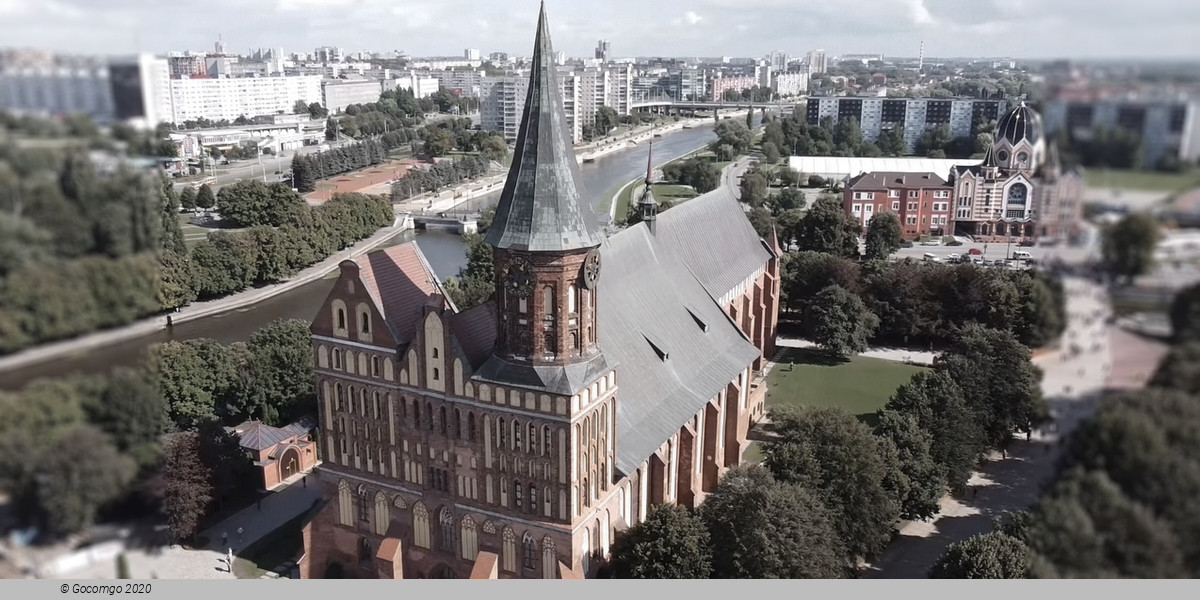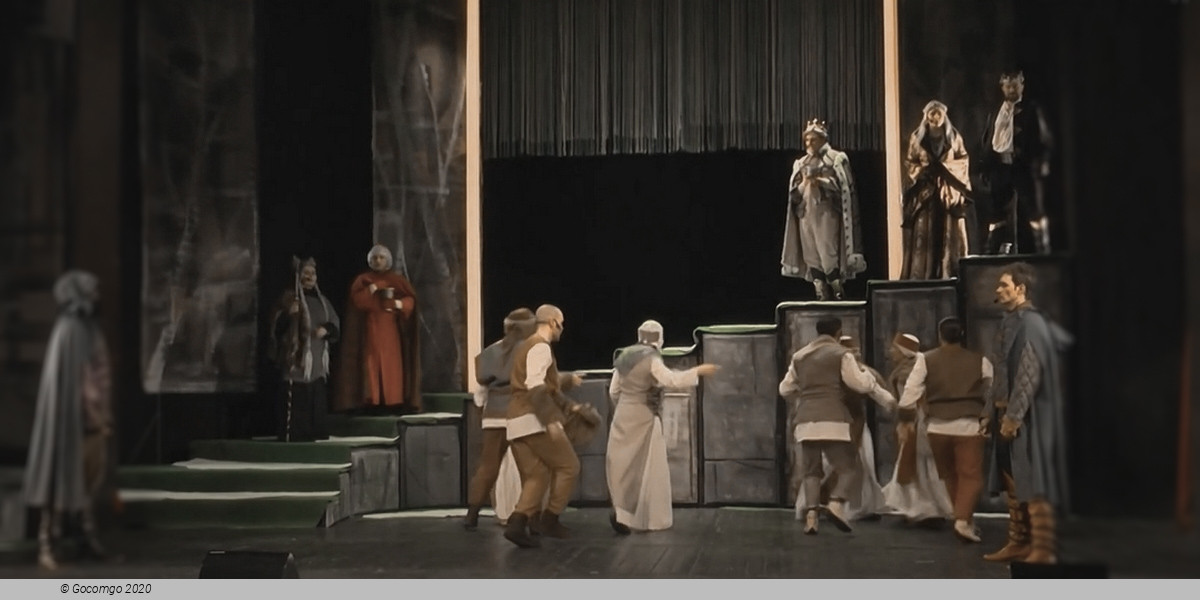Venues in Kaliningrad

Kaliningrad, until 1946 known as Königsberg, is the largest city and the administrative centre of Kaliningrad Oblast, the westernmost Oblast of Russia. The city is situated on the Pregolya River, at the head of the Vistula Lagoon on the Baltic Sea.
History
The history of the city may be divided into three periods: the Old Prussian settlement known as Twangste before 1255; the German city of Königsberg from 1255 to 1945 (fief of Poland 1466–1657); the Polish city of Królewiec from 1454 to 1455; the Russian city from 1945. In 1946 the settlement was renamed Kaliningrad in honor of the Soviet leader Mikhail Kalinin and was largely re-populated with ethnic Russians.
Twangste
Königsberg was preceded by a Sambian (Old Prussian tribe) fort called Twangste (also spelt Tuwangste or Tvankste), meaning Dam. During the conquest of the Zambians by the Teutonic Knights in 1255, Twangste was destroyed and replaced by a new fortress named Königsberg in the honor of Bohemian king Ottokar II. The declining Old Prussian culture finally became extinct around the 17th century, after the surviving Old Prussians were integrated through assimilation.
Königsberg
The settlement on the site of present-day Kaliningrad was founded as a military fortress in 1255 after the Prussian Crusade by the Teutonic Knights against Baltic Prussians. The new settlement was named in honor of the Bohemian (Czech) King Ottokar II. The crusade was followed by immigrant settlers from Germany and other regions of Western Europe. The city and surrounding area became predominantly German, with Polish, Lithuanian and Latvian minorities.
In 1454, the city found itself within the borders of Poland for a year thanks to King Kazimierz Jagiellończyk. After the secularization of the Teutonic Order in 1525, Königsberg became the capital of the Duchy of Prussia, a fiefdom of the Polish king (from 1466). As a symbol of its dependence, the black Prussian eagle had a crown thrust around its neck bearing the letter "S" from the Latinised name of the king, "Sigismundus." In 1618 the Duchy of Prussia passed under the control of the Electors of Brandenburg and in 1657 it became a sovereign state independent of the Polish king, controlled in personal union with Brandenburg (usually referred to as Brandenberg-Prussia). From 1701, Brandenberg-Prussia became a Kingdom and the entire area was referred to as the Kingdom of Prussia. While the Brandenberg portion was a part of the Holy Roman Empire and later the German Confederation, Prussia (later called East Prussia) was not included within those territorial boundaries.
In the ensuing two centuries the city, first as part of the Kingdom of Prussia, then from 1866 as part of the North German Confederation, and then from 1871 as part of the German Empire, continued to flourish and many iconic landmarks of Königsberg were built. The city had around 370,000 inhabitants and was a cultural and administrative center of Prussia and the German Empire. Immanuel Kant and E. T. A. Hoffmann, the notable sons of the city, were born during this time.
World War II
In World War II the city of Königsberg was heavily damaged by a British bombing attack in 1944 and the massive Soviet siege in spring 1945. At the end of World War II in 1945, the city became part of the Soviet Union (as part of the Russian SFSR).
Soviet Union
The U.S. President Harry Truman and the British Prime Minister Clement Attlee declared that they would support the proposal of the Conference at the forthcoming peace settlement.
On July 4, 1946, the Soviet authorities renamed Königsberg to Kaliningrad following the death on June 3, 1946, of the Chairman of the Presidium of the Supreme Soviet (titular head of state) of the USSR, Mikhail Kalinin, one of the original Bolsheviks. The remaining German population of Koenigsberg was forcibly moved to Germany in 1946–1949, and the city was repopulated with Soviet citizens (as a part of the agreement between the Allies and the Soviet Government). The city's language of administration was changed from German to Russian.
The city was rebuilt, and as the westernmost territory of the USSR, the Kaliningrad Oblast became a strategically important area during the Cold War. The Soviet Baltic Fleet was headquartered in the city in the 1950s. Because of its strategic importance, Kaliningrad Oblast was closed to foreign visitors.
In 1957 an agreement was signed and later came into force which delimited the border between Poland and the Soviet Union.
Russia
The town of Baltiysk, just outside Kaliningrad, is the only Russian Baltic Sea port said to be "ice-free" all year round, and the region hence plays an important role in the maintenance of the Baltic Fleet.
The Kaliningrad Oblast was an exclave of the Russian Soviet Federative Socialist Republic and with the collapse of the Soviet Union in 1991 it became separated from the rest of Russia by independent countries. This isolation from the rest of Russia became even more pronounced politically when Poland and Lithuania became members of NATO and subsequently the European Union in 2004. All military and civilian land links between the region and the rest of Russia have to pass through members of NATO and the EU. Special travel arrangements for the territory's inhabitants have been made through the Facilitated Transit Document (FTD) and Facilitated Rail Transit Document (FRTD).
While in the 1990s many Soviet-era city names commemorating Communist leaders were changed (e.g. Leningrad reverting to Saint Petersburg), Kaliningrad remains named as it was.
Since the early 1990s, the Kaliningrad oblast has been a Free Economic Zone (FEZ Yantar). In 2005 the city marked 750 years of existence as Königsberg/Kaliningrad. In July 2007, Russian First Deputy Prime Minister Sergei Ivanov declared that if US-controlled missile defense systems were deployed in Poland, then nuclear weapons might be deployed in Kaliningrad. On November 5, 2008, Russian leader Dmitry Medvedev said that installing missiles in Kaliningrad was almost a certainty.These plans were suspended, however, in January 2009
But during late 2011, a long-range Voronezh radar was commissioned to monitor missile launches within about 6,000 kilometers (3,728 miles). It is situated in the settlement of Pionersky (formerly German Neukuhren) in Kaliningrad Oblast.
In 2018, Kaliningrad hosted some games of the World Cup.


